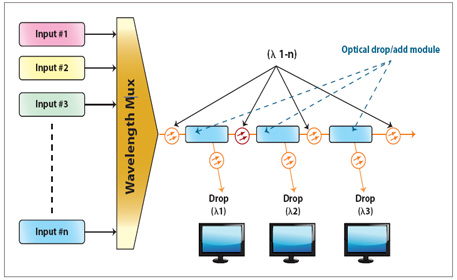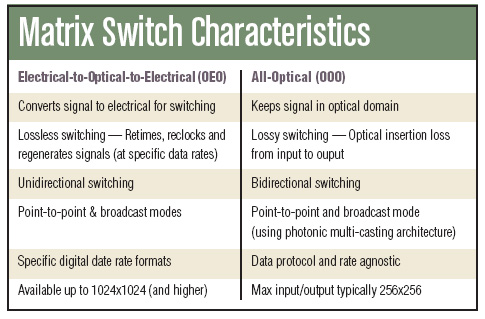Choosing An Optical Switch To Match Your Application
Optical switches are an integral part in fiber optic transmission systems and contribute to the development of the "all-optical" network. The AV market can adapt these telecom components to enhance the capabilities of the overall AV transport system. There are two basic types of optical switches, the OEO (Optical to Electrical to Optical) and the OOO, or all-optical switch. Each has its place in fiber optic systems with their unique features and capabilities.
The fiber industry's first optical switch was a simple mechanical 1x1 on-off switch using a moving fiber typically activated by a small DC control voltage. Since then a number of switch variations have evolved, including the more popular and versatile 1x2 switch. This switch is used as a building block to develop more complex switching systems for optical routing and broadcasting.
to convert the incoming optical signal to its native electrical digital data stream. Similar optical transceivers are used on each of the corresponding outputs to convert the switched electrical data stream back to an optical signal for further transmission. The switch matrix is electrical and includes other functions such as reclocking and retiming to help clean up the signal and return it to its original condition, discounting any conversion-related anomalies. Most of these switches are multi-rate and can support a wide variety of data rates from approx 5 Mbps up to 4.25 Gbps, and some even higher. However, the reclocking functions are generally performed at very specific data rates, namely 270Mbps, 1.485Gbps, 2.97Gbps, and 4.25Gbps. Other data rates are simply passed through the switch and regenerated without any retiming, reclocking, and reshaping of the electrical signal.
These OEO switches have several features worth noting:
Point-to-Multipoint (broadcasting) capability
Fully non-blocking
Uses Optical I/O (SFP devices) with electrical switch engine— electrical "3R" functions at selected data rates (Recovery, reclocking, and regeneration)
Does not degrade optical signal strength
Available up to 4.25Gbps (Fiber Channel) data rate
Available in configurations up to 1024 x 1024

Extron FOX 4G DA8 And FOX 4G SW8 some years ago and has evolved to suit the AV market. Products such as matrix and protection switches in addition to ROADM (Reconfigurable Optical Add Drop) and other function-specific optical switches are becoming staples in AV. The key feature of an all-optical switch is, as the name implies, that the signal is kept in the optical domain throughout the switching and routing process. This has clear advantages over the OEO switch in that the alloptical switch is data rate and protocol agnostic in the AV market space. That is, any of the standard AV signals (video, audio, and data) can be passed through the switch in any format (analog or digital). In addition, these switches can also send bi-directional data on the same port—something the OEO switch cannot do. In other words, bi-directional data on a single fiber (one port) can be easily routed in all-optical switches. (Please see the "Matrix Switch Characteristics" sidebar for a comparison of OEO and alloptical matrix switches.)
1xn Optical Switches: Many people consider fiber a simple replacement transport infrastructure to copper. This represents only one aspect of the overall capabilities of a fiber system. Once the signal is in an optical format a number of other switching and routing capabilities exist. As an example, a simple 1x4 or 1x8 optical switch provides routing and broadcast capabilities very easily and they are much less expensive than an OEO equivalent. Just as with the all-optical matrix switch, these optical broadcast switches are signal type, data rate, and format agnostic. Any signal that can be transported over fiber can be routed through one of these switches. An alternative to this is the 2x4 or 2x8 all-optical switch, which provides additional capabilities.

FIGURE 4: In a digital signage application, a Reconfigurable Optical Add-Drop Module (ROADM) can deliver specific content to a display while other wavelengths continue down the fiber to the next location. mission critical applications where it's important to ensure fiber continuity between the transmitter and receiver units. At the transmit location the signal is split into two redundant signals and sent over two diverse optical paths. This switch design accepts these two optical signals from the same transmitter via the different fiber paths and will monitor the optical activity on each fiber. One path is set as the primary optical path and will automatically switch to the redundant fiber path if this primary path were to be interrupted or if the signal level falls below a pre-determined optical threshold.
As with the other all-optical switches, this switch is data rate/protocol agnostic and will monitor and switch any optical signal presented to it. In addition, this switch design will also switch bi-directional information on the same fiber further increasing its flexibility and versatility for such applications as video conferencing, remote arraignment, video with PTZ control, HD video with audio talk-back, etc.
The OEO switch has its place in the AV market and is seeing increased use. As with any conversion process, there are always some artifacts or anomalies generated when converting from one format to another (optical to electrical and back) leading to increased errors and system degradation. All-optical switches do not have such anomalies and maintain the signals' high quality throughout the switching process. They also have much higher potential since they are protocol, data rate, and direction agnostic.
All-optical switches help define the advanced role of fiber in the AV market and further illustrate the fact that fiber is significantly more than just a replacement for copper. Once consultants better understand and accept the diverse capabilities of fiber, you will see increased and far-reaching AV applications using this technology, and at a lower cost.
This article provides an overview of some of the optical switch types and technologies available to system designers. Using these and other optical switch products, many other AV applications can be created to provide you with increased system versatility and help move to the holy grail of fiber systems—the all-optical network.
Ed Miskovic (emiskovic@meridiantech. com) is executive vice president of sales and marketing for Meridian Technologies.
